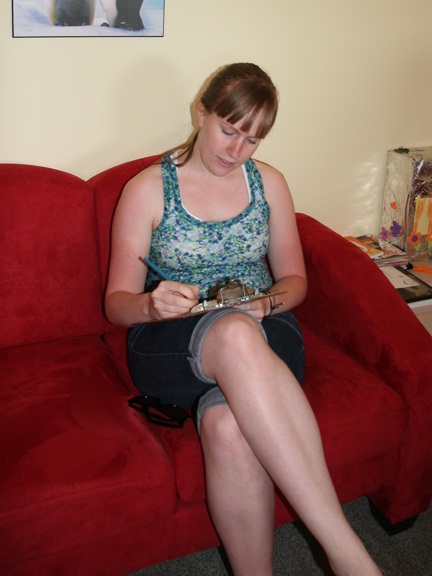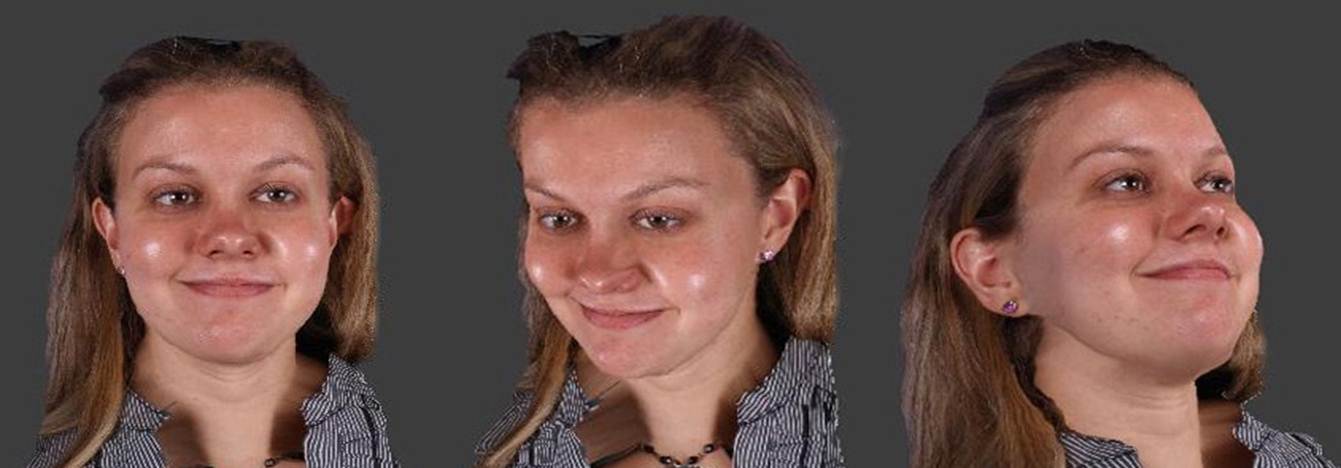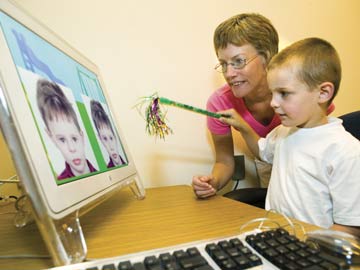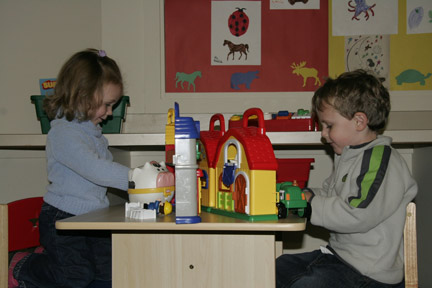|
Welcome to the Face Perception Lab
A SAMPLING OF CURRENT STUDIES
| STUDIES INVOLVING CHILDREN |
Recognizing emotional expressions is critical for successful social interactions. Although infants can discriminate some facial expressions, the ability to categorize and label facial expressions continues to improve throughout childhood. Our goal is to better understand the processes by which children learn to recognize facial displays of emotion. In most previous studies children have been tested with static images of isolated faces. Have these studies underestimated children’s ability to recognize emotions? Do children perform better when stimuli are dynamic and when faces are accompanied by other cues (e.g., bodies)? In collaboration with Nicole Nelson (a former postdoc, now at Queensland University, Brisbane) we are studying how children learn what different emotional expressions mean. In one study, children watch an adult open a series of boxes. As each box is opened, the adult poses an emotional expression; children are asked to guess what is inside each box based on the adult’s cue. We want to know where children look on the face to figure this out and how performance varies across expressions in different age groups. In another study, we are showing children either videos or static images of someone displaying a range of emotions; children are asked to provide a label for each display. Whether they see just the face, just the body, or the entire person varies across trials. The results of these and other ongoing studies will contribute to our knowledge of how emotion perception develops in typical children and ultimately will facilitate our understanding of how perception differs in special populations (e.g., children with autism).
|
|
Recognizing facial identity is also important in our daily lives. We have conducted numerous studies investigating children’s ability to discriminate and recognize unfamiliar faces (see Parent letters). However, almost nothing is known about how children learn to recognize new faces (e.g., their teacher) and whether their ability to recognize a familiar face is adult-like. We hope to shed new light on these important questions. To study familiar face recognition in adults we show them pictures of celebrities (e.g., actors and politicians). One of the challenges in working with children is that there are fewer individuals with whom all children are familiar. In an exciting new study, several staff members at a local school have agreed to provide us with pictures of their faces, allowing us a unique glimpse into how children process the faces of people they know. We want to see how well children can recognize pictures of their teacher(s) when the images vary naturally (e.g., in point of view, expression, hairstyle). This work has important implications for eyewitness testimony.
|
|
| ______________________________________________________________________________________________ |
| |
STUDIES INVOLVING YOUNG ADULTS:
|
 |
Recognizing Identities Despite Natural Variability in Images
In most studies of face recognition participants are shown only one or two images of a particular identity. In daily life, a person’s appearance varies. For example, people change hairstyle, are seen from a different point of view, and change expressions. When someone is familiar (e.g., a celebrity, a neighbour), recognizing images that vary naturally is trivial; however, when someone is unfamiliar we often think that two images of the same person are photos of different people. This, of course, has implications for the utility of photo identification. We are conducting a series of studies to investigate the influence of experience on the ability to recognize both familiar and unfamiliar identities despite variation in images. In collaboration with a student at Zhejiang Normal University (Jinhua, China) we are looking at how this ability differs when tested with own- versus other-race faces. Through International Services at Brock University, we are investigating the time course over which the ability to recognize Caucasian faces improves in students who had minimal experience with Caucasian faces prior to their arrival in Canada. Collectively, these studies will provide new information about two problems that has been largely ignored in psychology: How readily can we recognize faces of people we do not know and by what process does a face become familiar? |
Recognizing Emotional Facial Expressions
In most studies investigating adults’ perception of facial displays of emotion, stimuli comprise isolated faces posing intense expressions. In the real world, facial expressions are often subtle, dynamic, and accompanied by other cues. We have reported that both adults’ and children’s perception of facial expressions is influenced by other cues. For example, if shown a sad face paired with a fearful body posture, participants often report that the face is showing fear. These congruency effects challenge a long-held assumption that faces telegraph specific underlying emotions. We are continuing this line of research in several novel ways. First, we are creating dynamic displays of incongruent expressions; do these effects disappear when more realistic stimuli are presented? Second, we are investigating specific patterns of these congruency effects; is the perception of some expressions especially sensitive to interference effects? Third, are there cultural differences in these congruency effects that reflect local versus global processing? |
| ___________________________________________________________________________________________ |
STUDIES INVOLVING OLDER ADULTS
|
| |
|
|
|
Older adults comprise the fastest growing demographic group on earth. We are dedicated to understanding both how people perceive young versus older adult faces and how face perception changes as a function of aging. For example, we recently discovered that both young and older adults tend to have a poorer understanding of what is considered “normal looking” and attractive in older than in young adult faces, which suggests that people of all ages may have a more poorly defined mental representation of older adult faces. Reliance on this poorly defined representation may make us more likely to confuse older adult faces with each other. Even young children (aged 3 and 7 years) were more accurate when tested with young adult faces, suggesting that early experience tunes the perceptual system for young faces and that experience with older adults later in life does not reverse this pattern. In another study, we found that both young and older adults pay more attention to young than older faces when viewing faces in complex scenes. However, whereas young adults better recognize young than older faces, older adults exhibit equal recognition for both face ages. We are now investigating whether the context in which older adults are encountered influences the amount of attention they receive and how well they are remembered. In parallel to our studies with children and young adults, we also are testing the ability of older adults to recognize a particular identity despite changes in appearance. |
| _____________________________________________________________________________________________ |
Creation of a Database of Faces |
Would you like to contribute your face to our new 3-dimensional catalogue of faces? We are developing a state-of-the-art set of face stimuli using a very special camera that allows us to rotate images. A single picture can be shown from multiple points of view, making our tasks more similar to how we encounter faces in the real world. We took our camera to China to photograph both children and adults there. We are now collecting photographs of children, young adults, and senior citizens in the Niagara Region. Contribute your image to our ‘Let’s Face It’ gallery!
 |
|
| ____________________________________________________________________________________________ |
|
We are conducting several projects in collaboration with other research groups. Professor Mondloch is an Associate Investigator with the Australian Research Council Center for Excellence in Cognition and its Disorders. She and her students also collaborate with Professor Kang Lee (University of Toronto) and his colleagues in Jinhua, China to investigate cross-race effects in face perception. In addition, she collaborates with several colleagues at McMaster (Daphne Maurer & Terri Lewis) and at Brock (Cheryl McCormick; Kimberly Cote; Sid Segalowitz). Collectively, these studies involve investigating face perception following early visual deprivation due to bilateral congenital cataracts, perception of emotion after sleep deprivation, and perception of aggression in adult and child faces.
|
| _____________________________________________________________________________________________ |
|
| All child tasks are designed to be age-appropriate. For example, 4-year-olds are given a 'magic wand' in our tests of face recognition; they use that wand to put faces belonging to particular people (e.g., 'Johnny') on a bus. In another task they are asked to find pairs of identical faces and then invited to put those faces in the twin clubhouse. |
 |
| Experimenters play with each child in our waiting room until the child is ready to take part in the study. Parents are welcome to remain with their child throughout their visit to the lab. |
 |
| All trips to the lab end with a trip to the treasure box! |
 |
We are committed to making your visit fun and informative. We will provide free parking (and detailed directions/assistance); we will explain all of the tasks prior to beginning any test; we will take as much time as needed to explain each study and its practical implications prior to your departure.
|
| _________________________________________________________________________________________ |
|
|
You can phone the Face Perception Lab at Brock University; please feel free to ask any questions that you might have.
Parents: If you and your child(ren) would like to participate in our studies, we will create a file that includes each child's name, date of birth, gender and phone number. When your child is the 'right' age for a study, we will contact you and invite you to participate. Allowing us to put your child's name on file does not obligate you to participate.
Young and Older Adults: We will discuss ongoing studies with you and add your name to our database. At your convenience, we will schedule an appointment for you so that you can participate in our exciting studies.
All participants are encouraged (but not required) to add their face to our ‘Let’s Face It’ gallery of images – images that will enhance our ability to understand how people perceive one another across race, age, emotions, and point of view! |
You can also help
us by telling your friends about this new
research lab at Brock University! |
|

